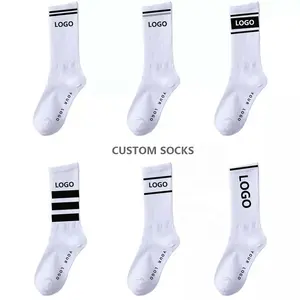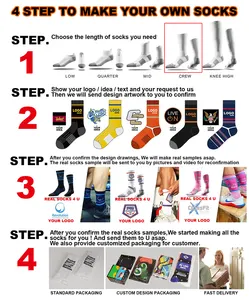(213833 products available)





























































































































































































OEM socks refer to custom-made socks that are manufactured according to the specifications and branding requirements of a particular company or brand. These socks are produced in bulk, often featuring unique designs, logos, and materials that align with the brand's identity. The OEM (Original Equipment Manufacturer) process allows companies to create personalized products without having to invest in the manufacturing infrastructure. This enables them to offer specialized socks that cater to their target market's preferences and needs, ensuring consistency in quality and design across all units produced.
Socks by Material
Socks by Length
Socks by Use
The design of custom sock OEM services varies based on the provider and the requirements of the client. However, several key components are usually included to ensure quality, comfort, and the ability to meet branding needs.
Branding and Customization
Branding is a pivotal aspect of sock design in OEM services. It involves the incorporation of the client's logo, brand colors, and other distinctive elements into the sock design. This ensures that the socks align with the overall brand identity. Customization options can range from unique patterns and color combinations to specific material choices. These choices cater to different market segments and consumer preferences.
Material Selection
Material selection is a critical factor in sock design. It impacts comfort, durability, and performance. OEM services work with clients to choose the right materials for their socks. These materials may include cotton, wool, synthetic blends, or specialized fabrics like merino wool or bamboo. Each material offers distinct benefits. For instance, cotton is known for its breathability and softness. On the other hand, synthetic blends offer enhanced moisture-wicking properties and durability.
Comfort and Fit
Comfort and fit are paramount in sock design. This involves the use of features such as arch support, cushioning, and seamless toe construction. These features enhance comfort and reduce friction. Additionally, sock length and style variations, ranging from ankle socks to crew and knee-high socks, are designed to cater to different preferences and activities. This ensures a personalized fit that enhances comfort throughout the day.
Functionality and Performance
Functionality and performance features are integrated into the sock design based on their intended use. For athletic socks, moisture-wicking properties and ventilation zones are crucial. They enhance breathability and keep feet dry during physical activities. On the other hand, compression socks may include graduated compression for improved circulation and support. Work socks might prioritize durability and reinforcement in high-wear areas to ensure longevity and comfort during extended use.
Sustainability and Eco-Friendly Options
As sustainability becomes increasingly important, many OEM sock services are incorporating eco-friendly materials and practices into their designs. This includes the use of organic cotton, bamboo fibers, and recycled materials. Additionally, eco-friendly production processes and packaging options are prioritized. This minimizes environmental impact and promotes a sustainable approach to sock manufacturing. This meets the growing demand for environmentally conscious products.
Casual Outfits:
Casual socks can be worn with sneakers or casual shoes, and they are perfect for everyday wear. One can wear them with jeans or shorts and a t-shirt or a casual shirt for a relaxed look. Funky socks can be worn with sandals or casual shoes to add a pop of color and fun to an outfit. Wearing socks of different colors or patterns can help express one's personality and style.
Formal Outfits:
Dress socks are worn with dress shoes and can be matched to an outfit in different ways. One can match the color of the socks with the color of the pants for a seamless look or match the socks with a tie or pocket square for a coordinated look. Socks should be neutral in color with formal wear, such as black, navy, or gray, and should complement the overall outfit.
Sporting activities:
Sports socks are designed for specific activities and are worn with appropriate footwear. Running socks should be worn with running shoes and should be moisture-wicking to keep the feet dry. Basketball socks should be cushioned and worn with high-top basketball shoes for support and comfort. Other activity-specific socks include hiking socks, which should be worn with sturdy hiking boots, and cycling socks, which should be worn with cycling shoes.
Seasonal Outfits:
Socks also vary with the seasons. Winter socks are thicker and warmer, perfect for colder weather. They should be worn with boots and layered with another pair of thinner socks for extra warmth. Summer socks should be lighter and breathable, worn with sandals or lightweight shoes. Bamboo socks are an excellent choice for summer as they are moisture-wicking and keep the feet cool.
Fashion Statements:
Socks can also be used to make a fashion statement. Sock and sandal combinations are trendy and can be styled in various ways. One can wear patterned or colored socks with sandals for a bold look or choose neutral-colored socks for a more subtle look. Layering socks is another way to create a unique style. One can wear two different socks together or layer a thinner sock under a thicker one for added warmth and texture.
Q1: What are the benefits of custom-designed socks?
A1: Tailored socks offer branding opportunities, strengthen brand recognition, and improve product differentiation. These socks also allow companies to keep up with current fashion trends.
Q2: What is the production process of bespoke socks?
A2: The process involves design development, material selection, sock knitting, sock finishing, quality control, and packaging.
Q3: What are the popular types of socks for customization?
A3: The popular types include athletic, crew, no-show, and ankle socks.
Q4: What are the main materials used in sock production?
A4: The main materials are cotton, wool, polyester, and nylon.
Q5: What are the considerations when selecting a supplier?
A5: Consider the supplier's experience, production capacity, material quality, and delivery time.